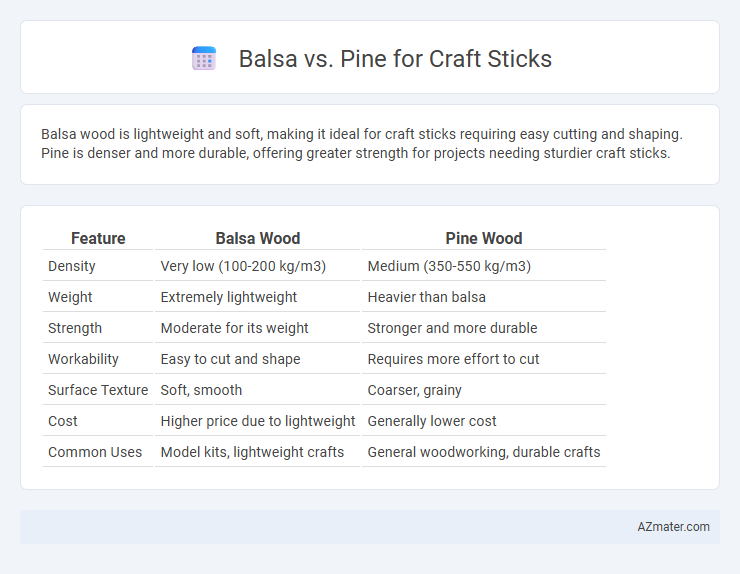Balsa wood is lightweight and soft, making it ideal for craft sticks requiring easy cutting and shaping. Pine is denser and more durable, offering greater strength for projects needing sturdier craft sticks.
Table of Comparison
| Feature | Balsa Wood | Pine Wood |
|---|---|---|
| Density | Very low (100-200 kg/m3) | Medium (350-550 kg/m3) |
| Weight | Extremely lightweight | Heavier than balsa |
| Strength | Moderate for its weight | Stronger and more durable |
| Workability | Easy to cut and shape | Requires more effort to cut |
| Surface Texture | Soft, smooth | Coarser, grainy |
| Cost | Higher price due to lightweight | Generally lower cost |
| Common Uses | Model kits, lightweight crafts | General woodworking, durable crafts |
Introduction to Balsa and Pine for Craft Sticks
Balsa wood, known for its lightweight and soft texture, is ideal for craft sticks requiring easy shaping and quick assembly. Pine, a denser and more durable softwood, offers greater strength and sturdiness for projects needing structural support. Selecting between balsa and pine depends on the balance between weight, durability, and the specific requirements of the craft project.
Material Properties: Balsa vs Pine
Balsa wood is significantly lighter and softer than pine, making it ideal for craft sticks requiring easy cutting and shaping. Pine features greater density and strength, providing more rigidity and durability for structural craft projects. The cellular structure of balsa offers excellent buoyancy and flexibility, whereas pine's resin content enhances weather resistance and hardness.
Strength and Durability Comparison
Balsa wood is significantly lighter and softer than pine, making it easier to cut but less durable under stress, while pine offers greater strength and resistance to wear, ideal for craft sticks requiring sturdiness. The density of pine typically ranges from 350 to 500 kg/m3, providing enhanced load-bearing capacity compared to balsa's 100 to 160 kg/m3 density. For projects prioritizing long-term durability and impact resistance, pine craft sticks outperform balsa in maintaining structural integrity over time.
Weight and Flexibility Differences
Balsa wood is significantly lighter than pine, with a density of approximately 160 kg/m3 compared to pine's 500 kg/m3, making it ideal for craft sticks requiring minimal weight. Balsa offers superior flexibility due to its open grain structure, allowing it to bend without breaking, whereas pine is stiffer and more prone to cracking under stress. These weight and flexibility differences make balsa a preferred choice for lightweight, flexible crafting projects, while pine is suited for sturdier, less flexible applications.
Ease of Cutting and Shaping
Balsa wood is significantly easier to cut and shape than pine, due to its lightweight and soft texture, making it ideal for detailed craft stick projects. Pine tends to be denser and harder, requiring sharper tools and more effort to achieve precise cuts and intricate shapes. For hobbyists seeking quick manipulation and finer craftsmanship, balsa offers superior ease and versatility in cutting and sculpting.
Finishing and Painting Qualities
Balsa wood offers a smooth, lightweight surface that readily absorbs paint and finishes, resulting in vibrant colors and quick drying times, ideal for craft sticks requiring fine detail and seamless coatings. Pine, being denser with a more pronounced grain, may need sanding and priming before painting to achieve an even finish, often affecting the paint's texture and longevity. Both woods can be finished well, but balsa's softness allows for easier manipulation and superior paint adherence, making it preferable for projects emphasizing precise finishing and vibrant painting.
Cost and Availability
Pine craft sticks are generally more affordable due to the wood's widespread availability and faster growth rate, making it a budget-friendly option for large-scale projects. Balsa wood, though pricier, offers superior lightweight strength and is less common, which affects both its cost and availability in craft supply stores. Many crafters choose pine for cost efficiency, while balsa is preferred for specialized crafts requiring fine detail and durability.
Best Uses for Balsa Craft Sticks
Balsa craft sticks are best suited for lightweight model building, architectural prototypes, and delicate craft projects due to their soft texture and easy-to-cut nature. Their low density provides excellent buoyancy and flexibility, making them ideal for crafting model airplanes and boats. In contrast, pine sticks are harder and more durable, preferred for projects requiring greater structural strength and longevity.
Ideal Applications for Pine Craft Sticks
Pine craft sticks are ideal for projects requiring durability and strength, such as structural models, DIY crafts, and woodworking prototypes. Their sturdy nature makes them suitable for educational kits, model building, and general crafting where resistance to bending and breaking is essential. Pine's affordability and availability also make it a practical choice for bulk craft stick applications.
Conclusion: Choosing the Right Wood for Your Project
Balsa offers superior lightweight properties and ease of cutting, making it ideal for intricate craft stick projects requiring precision and minimal weight. Pine provides greater strength and durability, suitable for structures that demand sturdiness and long-lasting support. Selecting between balsa and pine depends on whether your project prioritizes delicate craftsmanship or robust construction.

Infographic: Balsa vs Pine for Craft Stick
 azmater.com
azmater.com